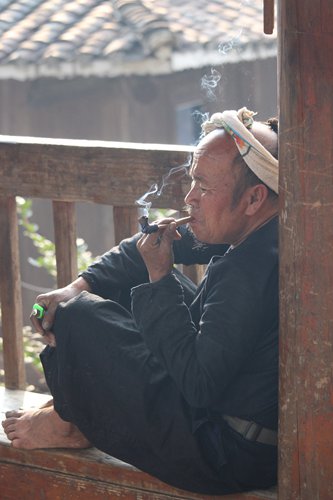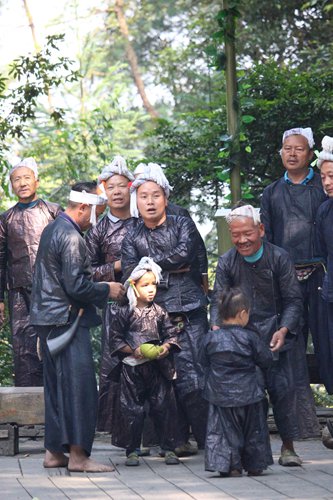HOME >> LIFE
Ethnic minority tribe keeps its traditions despite globalization
By Rainer Feldbacher Source:Global Times Published: 2019/8/22 15:33:40

An elderly Miao man smokes a pipe. Photo: Courtesy of Rainer Feldbacher

Residents of Basha village in Guizhou Province pose for a picture. Photo: Courtesy of Rainer Feldbacher

Basha village Photo: Courtesy of Rainer Feldbacher
Mountainous and undeveloped, Guizhou is one of China's poorest provinces. Demographically, however, it is rich in diversity. At the foot of Moon Mountain in the endlessly dense forests of Congjiang county is a small hidden mountain village where the last hunter tribe of the Miao people live. The village's inhabitants are not only the last people in China still legally able to carry real firearms, but they also have other characteristics: They worship trees as bearers of the soul, live in their wooden houses, practice centuries-old customs and have their own unique beliefs.
Retaining tradition
From Kailin there are now good connections to various villages of the Miao, Yao and Dong, the major ethnic groups in Guizhou, among them are the townships Xijiang and Zhaoxing. However, if travelers want to gain deeper insight into the ethnic groups of Guizhou, the Miao village Basha is the best place to go. The village is perched on a hill. The name "Basha" means "place with lush forest" in the Miao language.
The villagers lead a self-sufficient life in the hilly areas in their diaojiaolou, traditional wooden structures built on wooden stakes. The society has nature worshiping tendencies, adoring water sources and trees as their sacred totems. The latter are especially seen as the incarnations of their ancestors. When a child is born, parents plant a tree with the wish that their child may grow up with the same strength as the tree. Although cutting down ancient trees is forbidden, when a person dies, their birth tree is often used to make their coffin.
Another characteristic is the special haircut of the men in the tribe. Like men during the Qing dynasty (1644-1911), the men of Basha wear their long hair in braids. They attach great importance to this, believing their braids are a symbol of masculinity and power. Young boys have to take part in their first shaving ceremony between the ages of 7 and 15 as a rite of passage. The tribe's leader wets a sickle with water used to boil eggs and shaves off all of the boy's hair except for the central part, which is coiled into a bun. This shave is done without any shaving cream or even a rinse. The boys can decide from a certain age if they want to remove or retain their hair except for their braid. At the age of 15, a hunting rifle is given to them as a sign that they have become adults. This point is exceptional or unique in China because the residents of Basha are the only ones legally allowed to have private rifles, wearing them over their shoulders, with a knife, powder horn and other hunting utensils at their belts. Beside the living customs, they also retain traditional clothes. The purple clothes they wear represent bark. The Basha people usually add egg whites into the indigo when dying the coarse cloth to make it shiny and waterproof.
Ethnic pride
At sunrise, the mountains and houses are only silhouettes and the valley remains mist-covered until the fog clears more and more and exposes the valley with its rice fields and the dense forests. Scattered around the villages' open spaces and hillside are other wooden structures commonly called "rafts" or "racks." They are used to dry un-husked rice. In the early mornings, the only noise that can be heard are the crowing of roosters and the singing of women at work. With the dawn of the day, the village slowly wakes up as the field workers and the washing women head for work and children go on their way to school.
In the past, the villagers preferred to stay among themselves and barely maintained contact with the outside world. Better roads, such as the highway 321, that were built in the early 1980s encouraged strangers to come to the region. Thus, despite the still authentic life, the village became gated like a theme park, with shows three times a day.
Cultural tourism is broadly defined as tourism that engages the culture, lifestyle, art, architecture, religion, and can include activities such as homestays and visits to a place of worship.
For many ethnic minorities, tourists are also a channel for them to show off their ethnic pride, thus keeping it alive.
Such cultural tourism exposes many people to other traditions and ways of living and is generally positive for cross-cultural understanding. For ethnic groups whose traditions may have faded with the rise of globalization, cultural tourism often allows an outlet for them to revive their traditions, even if only through performances.
And of course, financially speaking, cultural tourism is a great source of income for people who live in more rural areas with few economic opportunities.
Although Basha is a non-Han Chinese ethnic group village, one can really gain real insight into ancient China there. The residents have worked hard to participate in the country's economic progress but have also managed to preserve their identity. Basha is an excellent role model for rural villages, opening to the world while keeping their tradition and authenticity.
Newspaper headline: The last hunters
Posted in: FEATURE,ADVENTURES